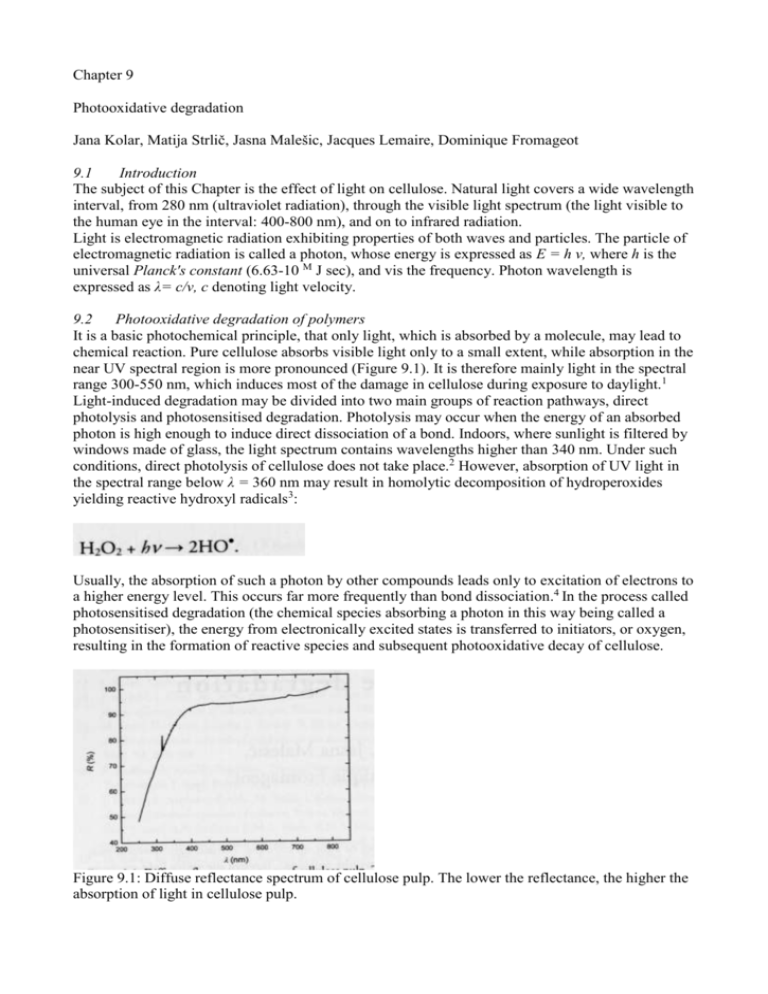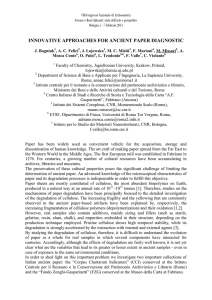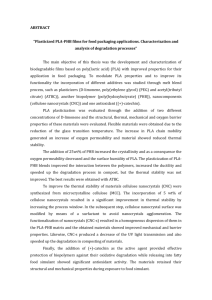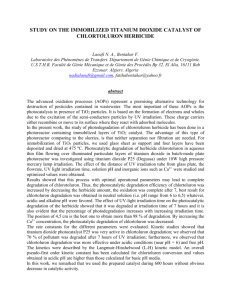Chapter 9 Photooxidative degradation Jana Kolar, Matija Strlič
advertisement

Chapter 9 Photooxidative degradation Jana Kolar, Matija Strlič, Jasna Malešic, Jacques Lemaire, Dominique Fromageot 9.1 Introduction The subject of this Chapter is the effect of light on cellulose. Natural light covers a wide wavelength interval, from 280 nm (ultraviolet radiation), through the visible light spectrum (the light visible to the human eye in the interval: 400-800 nm), and on to infrared radiation. Light is electromagnetic radiation exhibiting properties of both waves and particles. The particle of electromagnetic radiation is called a photon, whose energy is expressed as E = h v, where h is the universal Planck's constant (6.63-10 M J sec), and vis the frequency. Photon wavelength is expressed as λ= c/v, c denoting light velocity. 9.2 Photooxidative degradation of polymers It is a basic photochemical principle, that only light, which is absorbed by a molecule, may lead to chemical reaction. Pure cellulose absorbs visible light only to a small extent, while absorption in the near UV spectral region is more pronounced (Figure 9.1). It is therefore mainly light in the spectral range 300-550 nm, which induces most of the damage in cellulose during exposure to daylight.1 Light-induced degradation may be divided into two main groups of reaction pathways, direct photolysis and photosensitised degradation. Photolysis may occur when the energy of an absorbed photon is high enough to induce direct dissociation of a bond. Indoors, where sunlight is filtered by windows made of glass, the light spectrum contains wavelengths higher than 340 nm. Under such conditions, direct photolysis of cellulose does not take place.2 However, absorption of UV light in the spectral range below λ = 360 nm may result in homolytic decomposition of hydroperoxides yielding reactive hydroxyl radicals3: Usually, the absorption of such a photon by other compounds leads only to excitation of electrons to a higher energy level. This occurs far more frequently than bond dissociation.4 In the process called photosensitised degradation (the chemical species absorbing a photon in this way being called a photosensitiser), the energy from electronically excited states is transferred to initiators, or oxygen, resulting in the formation of reactive species and subsequent photooxidative decay of cellulose. Figure 9.1: Diffuse reflectance spectrum of cellulose pulp. The lower the reflectance, the higher the absorption of light in cellulose pulp. It is believed5 that the free radical mechanism of photosensitised oxidation of cellulose in the presence of sunlight proceeds through a chain reaction similar to that proposed by Bolland for thermal degradation of hydrocarbons in liquid phase,6 with the length of the photooxidation kinetic chain about 40 cycles. The application of the mechanism to cellulose was already reviewed7'8 and is discussed in Chapter 7. In the absence of light, it has been proposed that autoxidation in simple sugars is initiated by carbonyl groups, which react with oxygen, forming Superoxide. It has recently been demonstrated that the rate of oxidative degradation of polysaccharides during thermal accelerated ageing depends on the amount of carbonyl groups in the starting material.910 In the case of light induced degradation, the most often discussed sources of radicals are ketones and hydroperoxides.3 Ketones Ketones may absorb radiation in the near-UV or visible region of the electromagnetic spectrum due to n-π* transition, where an electron is excited from a nonbonding (η) into an antibonding (π*) orbital. An excited ketone in a singlet state has the tendency to return to a lower energy triplet state. This may occur via photophysical (e.g. fluorescence, phosphorescence, energy transfer), or photochemical reactions. The most important processes include Norrish type I and II reactions (introduced in Chapter 2, page 16),11'12 named after the Nobel laureate R.G.W. Norrish. Radicals formed during homolytic fragmentation induce oxidative decay according to the Bolland mechanism, while the excited carbonyls produced during the heterolytic fragmentation act as photosensitisers. Thus, an excited carbonyl may transfer the energy to other molecules, resulting in electronically excited states of e.g. oxygen (singlet oxygen), which may add to double bonds thus leading to formation of peroxides. The importance of carbonyl groups in cellulose on degradation of irradiated cellulose is demonstrated by a study involving a variety of differently deacidified bleached chemical pulps with different contents of carbonyl groups (Figure 9.2). Figure 9.2: Rate constant of degradation of different bleached chemical pulps, deacidified using calcium bicarbonate, during irradiation in Xenotest with 75 W m-2 (λ > 340 nm) and 50% RH. The error bars represent SD (n = 3). Hydroperoxides Hydroperoxides are considered to be the key compounds in initiation of polymer photooxidation. In addition to homolysis of peroxides mentioned above, transition metal ions in the reduced state, such as Fe2t and Cu\ catalyse decomposition of peroxides via the Fenton reaction," which is believed to be the main source of hydroxyl radicals during thermal accelerated ageing of cellulose:14 Fe2+ + H2O2 -> Fe3+ + HO● + HO‾. However, in the presence of UV light and ferric ions, oxidation of organic materials is enhanced due to reduction of Fe3t with water: Fe3+ + H2O + hv -> Fe2+ + H+ + HO●, yielding hydroxyl radicals and simultaneously producing Fe2+, which may enter into the Fenton reaction. These reactions are known to be the driving force behind photochemical self-cleaning in atmospheric and aquatic environments and are exploited for wastewater treatments.15 Changes in peroxide content during irradiation of cellulose in Xenotest (Xenochrome 320 filter, 70 W m-2, 60 °C controlled with a black panel thermometer, at 30% RH) were followed using dynamic chemiluminometric experiments in nitrogen atmosphere (as described on page 135). The original non-irradiated cellulose sample exhibits a chemiluminescence maximum at ca. 130-140 °C (Figure 9.3, curve a), the phenomenon usually interpreted as decomposition of peroxides.16 It is also known that by irradiation, even using an incandescent light source, a chemiluminescent species is formed (exhibiting an elevated signal in Figure 9.3, curve b, at T < 100 °C), which was interpreted as a charge-transfer complex between atmospheric oxygen and some appropriate structure in the polysaccharide, e.g. glycosidic or carbonyl oxygen.16 However, it is also interesting that only after 10 min of irradiation, some of the peroxides present in the original material are already decomposed (CL emission at 130 °C in curve b is considerably lower than in curve a). It is likely that this is due to homolytic decomposition of hydroperoxides. Enhanced radical activity thus induced leads to an elevated peroxide signal upon subsequent storage in darkness (Figure 9.3, curve c).17 Figure 9.3: Dynamic chemiluminometric experiments in nitrogen atmosphere for a — untreated; b — Xenotest irradiated sample for 10 min; and c — Xenotest-irradiated (10 min) and subsequently stored 580 min at 23 °C in darkness.17 9.3 Free radicals during irradiation of cellulose Free radicals were detected in irradiated cellulose with electron spin resonance spectroscopy (ESR). Phillips et al.2 studied the behaviour of cotton cellulose irradiated by light in the spectral region 325-400 nm, and demonstrated that most radicals were formed at 360 nm. However, Hon et al. detected only a trace amount of radicals in the presence of oxygen and light with wavelength higher than 330-349 nm.18 Further ESR studies suggested that various carbon-centred radicals are formed during irradiation with UV light, to which oxygen adds readily thus forming peroxyl radicals. Hydroperoxides are formed by abstraction of hydrogen by peroxyl radicals, 19 which may decompose to hydroxyl radicals as discussed above. The formation of hydroxyl radicals during irradiation of Whatman paper containing calcium carbonate was followed using the Ar,7V-(5-nitro-l,3-phenylene)bisglutaramide (NPG) hydroxylation assay,17 as described in Chapter 7 (page 119). NPG reacts with hydroxyl radicals forming orange coloured ortho- and para- hydroxylated products, which may be determined using colourimetry. As a reference experiment, NPG was added to a fibrous glass filter sheet, which allows us to observe formation of its hydroxylated products formed in the absence of cellulose. Namely, it is known that aromatic substrates are hydroxylated when irradiated by light, the first step in their photooxidation being the reaction between aromatic hydrocarbons and singlet oxygen.20 From the increase of diffuse reflectance at 450 nm it is evident that hydroxyl radicals are formed even in the absence of cellulose, however, the reaction is much more pronounced in its presence, indicating the formation of hydroxyl radicals during irradiation of cellulose (Figure 10.4). time (h) Figure 9.4: Decrease of diffuse reflectance at 450 nm (absorption maximum of hydroxylated derivates of NPG) plotted against duration of photoageing for calcium carbonate containing purified cotton paper (WH CaCO3) and fibrous glass filter sheets as reference material. The samples were irradiated using filtered xenon arc source (λ > 340 nm), with energy density 500 W m-2 in Heraeus Suntest CPS+ unit for up to 6 h.17 9.4 Depolymerisation of cellulose due to irradiation The effect of light as well as post-irradiation effects on cellulose properties may be evaluated using size exclusion chromatography (SEC)21 or viscometry. Viscometry may yield an underestimated DP of heavily oxidised cellulose22 although in such cases a reductive pre-treatment can be used. A further advantage of SEC is that it enables determination of distribution of molar masses. However, the technique is time-consuming and the data are less reproducible than viscometric data. Besides, SEC in LiCl/N,N-dimethylacetamide suffers from systematic errors which are difficult to evaluate23. In order to evaluate whether viscometry may be employed to study the degradation of cellulose during irradiation and after subsequent storage in darkness, it was necessary to establish whether a substantial amount of cross-linked material is formed during irradiation. Figure 9.5: Number distribution of Whatman cellulose containing calcium carbonate, irradiated in a SEPAP photoageing unit at 60 °C for A - 0 h, B - 333 h, C - 667 h, and D - 1430 h.17 Photooxidative reactions lead to gradual depolymerisation of cellulose, as demonstrated in Figure 9.5, where number-average molar mass distribution of polymer is presented. Degradation is not random, as a second peak with a lower number average distribution appears in photodegraded cellulose. However, no high-molecular weight fraction appears in the irradiated sample (Figure 9.6), meaning that cross-linking is not a dominant process. This justifies the use of viscometry for light-irradiated cellulosic materials, and the Ekenstam equation,24 discussed in Chapter 3 (eq 3.7) may be applied. Figure 9.6: Mass distribution of Whatman paper sample containing calcium carbonate, irradiated in a SEPAP photoageing unit at 60 °C for A - 0 h, B - 333 h, C - 667 h and D - 1430 h. In order to conduct the natural-light ageing experiment, paper samples were placed behind a southfacing window for an extended period of time (2. Feb. - 10. Aug. 2004) and sampled in appropriate periods of time. Using a thermo-hygro-lux meter Telehum (Euromix, Slovenia), temperature, relative humidity, and light intensity were continuously followed (Figure 9.7). Neither temperature nor relative humidity were regulated during the exposure. Average daily relative humidity increased during the experiment, due to the change of season and ranged from 20% during winter, to above 70% in summer. Figure 9.7. Exposure value (lux h) and relative humidity (%) during the experiment with natural light irradiation (2. Feb. - 10. Aug. 2004, south-facing window, Ljubljana, Slovenia). Figure 9.8: Temperature, relative humidity and illumination vs. time on 5. Dec. 2004, Ljubljana, Slovenia. During one day, conditions may vary considerably, as stronger illumination behind the window around noon time results in higher temperatures (up to 50 °C), leading to a decrease in relative humidity to a few percent only (Figure 9.8). The recently released ASTM D 6789-02 standard test method for accelerated light ageing of printing and writing paper by xenon-arc exposure apparatus requires glass filtration, irradiance of the lamp 765 ± 75 W m-2 determined in the 290 to 800 nm wavelength range, for 48.0 ± 0.5 h, subsequent storage in darkness for 24 h, after which brightness is determined according to ISO 2470 (diffuse reflectance at 457 nm) or yellowness (b*) according to TAPPI T 524. The temperature at paper surface during irradiation should be between 20 and 30 °C and humidity about 0.007 kg per kg of dry air, which equals 49% RH at 20 °C and 27% at 30 °C. Two often used photo-ageing ovens, Xenotest Alpha by Atlas Material Testing Solutions and Suntest CPS+ by Heraeus Industrietechnik were used for the evaluation of the standard. Both have xenon arc light sources. While samples are laid horizontally on a tray below the arc in Suntest CPS+, they rotate around it in Xenotest Alpha, which assures a more uniform irradiation. In addition, relative humidity can be adjusted in Xenotest Alpha, but not in Suntest CPS+. Table 9.1: Ambient and chamber temperature and relative humidity during artificial photoageing experiments according to the standard ASTM D 6789-02 and in the evaluation study. In this study and throughout this Chapter, power settings refer to the respective photoageing unit type (cf. page 52). The corresponding energy density throughout the spectral range in question can thus be estimated. The temperature was set as low as possible (black panel temperature 50 °C) and the relative humidity in Xenotest 50%. The ambient conditions and the ones achieved in the ageing oven are summarised in Table 9.1. Due to the rather high ambient temperature, which was largely the consequence of heating due to the operating photo-ageing chambers, the temperature inside both ageing chambers was slightly higher than 30 °C, which is the maximum allowed temperature according to the ASTM standard. The white standatd thermometer was used to continuously record temperature close to the surface of a paper sample and was 32 ± 1 °C. The ambient relative humidity was quite low, 15% in the room with Suntest CPS+ equipment, which resulted in an even lower relative humidity inside the ageing chamber (4%), which is far lower than the one prescribed by the standard. The Xenotest Alpha unit met the relative humidity requirement as it allows its adjustment. Otherwise, the standard conditions can thus only be met if the ageing units are situated in an airconditioned room with the conditioning system strong enough to compensate for the significant heating effect produced by the photo-ageing chambers. For Suntest CPS+ apparatus, the room should also have a possibility of relative humidity control. The SEPAP 12/24 photo-ageing unit, which uses a medium pressure mercury vapour arc light filtered with borosilicate glass was also included in the studies. Illuminance was not controlled, while the temperature of paper surface during the study was 60 °C. 9.6 Natural light and accelerated photoageing In a recent study, Whatman paper was exposed to irradiation in Xenotest Alpha and Suntest CPF+ at 70 W m-2 for 3 days. Relative humidity in Xenotest was set to 50% RH. The white standard thermometer, simulating the temperature of the irradiated Whatman paper during the experiment was 32 ± 1 °C. Figure 9.9: Decrease of brightness during irradiation of Whatman paper, and Whatman paper containing CaCO3 and MgCO3, in Xenotest (70 W m-2 , 32 °C and 50% RH). The error bars represent SD. Figure 9.10: Changes in DP of cotton paper sample (sample C) during exposure to daylight over time, and the same plot transformed according to the Ekenstam equation. According to the ASTM standard, brightness of paper after irradiation should be determined (diffuse reflectance at 457 nm). Irradiation of Whatman paper in Xenotest resulted only in a minor change of brightness. This is not surprising, as the chromophores, which are formed during irradiation, absorb visible light which may then lead to their decomposition (Figure 9.9). However, no visible damage does not imply that there is no degradation. DP of irradiated samples was determined viscometrically and the rate constant of cellulose degradation was determined using the Ekenstam equation (Figure 9.10). Figure 9.11: Decrease of DP during irradiation of Whatman paper and Whatman paper containing CaCO3 and MgCO3, by daylight behind a window, in Xenotest (70 W m -2, 32 °C and 50% RH), Xenotest (70 W m -2, 32 °C and 10% RH) and Suntest (700 W m-2, 32 °C and 5% RH). The error bars represent SD. Despite the fact that only a small increase of brightness is observed after irradiation, DP of the exposed paper decreased drastically, as evident from Figure 9.11. Using various ageing methods, similar degradation rates were obtained for untreated and CaCO3containing Whatman paper. However, a marked decrease in stability of paper containing MgCO3 is observed during irradiation in Xenotest at 50% relative humidity. Namely, the paper deacidified by Mg(HCO3)2 degraded 3.7 ± 0.8 times faster than the one containing CaCO3. Ageing in the SEPAP ageing oven, where the tempetature was 60 °C and relative humidity below 5%, proceeded in a similar manner as in Suntest.17 The pronounced differences in stability of deacidified paper, exposed to irradiation in Xenotest at 50% RH, as opposed to irradiation by daylight, Xenotest at 10% RH or Suntest apparatus, are most probably caused by differences in relative humidity levels during the experiments. While RH can be maintained at 40-60% in Xenotest, it may decrease below 10% in Suntest. As evident from the Figure 9.11, conditions during natural-daylight irradiation may be closer to those obtained in Suntest, as stronger illumination behind the window around noon time results in higher temperatures (up to 50 °C), leading to a decrease in relative humidity to a few percent only (Figure 9.8). When artefacts are exposed to light during exhibition, light levels are usually controlled, and so are relative humidity and temperature, and degradation may be best approximated by ageing in Xenotest. The degtadation rate constant for Mg(HCO3)2-deacidified Whatman paper in Xenotest suggests that if exposed to 100 lux hf for 12 h each day over a period of 100 days, its DP would decrease by 14%. An equivalent sample, stored in darkness for the same period of time, would not degrade to a detectable extent. However, it is important to keep in mind that the xenon arc, equipped with a glass filter, as prescribed by the ASTM standard, has a spectral energy distribution between 320 and 800 nm. This spectral distribution is broader than the one of indoor light present during exhibitions, where the UV portion of the spectrum (below 400 nm) is usually cut off by filters. Figure 9.12: Values of degradation rate constants during thermal ageing at 80 °C and 65% RH with the bars representing the calculated uncertainty interval ±SD. Sample designation: WH (untreated Whatman), WH Ca (Whatman containing CaCO3) and WH Mg (Whatman containing MgCO3). Figure 9.13: "Rate constants" of yellowing during p — photoageing (Xenotest, 70 W m -2, 30 °C, 50% RH); and t - subsequent thermal ageing (80 °C, 65% RH) of: WH - untreated Whatman; WH Mg - deacidified using Mg(HCO3)2; WH Ca - deacidified using Ca(HCO3)2. The error bars represent SD. Exhibited objects eventually return into dark repositories. Here, the previously irradiated artefacts will continue to degrade faster than the unexposed ones (Figure 9.12). When Whatman paper, irradiated for 3 days at 70 W m -2, was exposed to subsequent thermal ageing at 80 °C and 65% RH, it degraded ar a rare which was 40% faster than the unexposed sample. The effect was even more obvious in the case of deacidified paper, as the one containing CaCO3 was 30 times less stable and the one containing MgCO3 50 times, if compared to non-irradiated samples. Although no significant change of brightness was observed, either during the irradiation, or during subsequent 12-day storage in the dark at room temperature, only 3 days of thermal accelerated ageing at 80 °C and 65% RH resulted in a dramatic decrease of brightness (Figure 9.13). The extent of change depended on the extent of depolymerisation induced by irradiation and is in accordance with the results presented in Figure 9.3 and the accompanying discussion. 9.7 Conclusions The importance of oxidative reactions during degradation of organic materials irradiated by light is well established. During light-induced degradation of cellulose, carbonyl groups play an important role, while evolution of hydroperoxides and hydroxyl radicals has also been demonstrated. Photooxidative reactions lead to gradual depolymerisation and it was shown that degradation is not random. However, no high-molecular-weight fraction appears in the irradiated samples, meaning that cross-linking is not a dominant process. This justifies the use of viscometry for characterisation of cellulosic materials irradiated by light. As the low-molecular-weight fraction is relatively non abundant, the Ekenstam equation may be used for determination of the rate constants. Results suggest that the recent ASTM D 6789 standard procedure for photo-ageing of paper may need revision: — The standard requirements for temperature and relative humidity may often only be reached when ageing chambers are placed in a room with controlled temperature and relative humidity. Opting for lower irradiance, e.g. 500 W m"2, would have enabled easier control of the ageing conditions and at the same time increase the durability of the xenon arc. — Results suggest that relative humidity may play an important role. A narrower interval of the allowed relative humidity than prescribed by the standard (49% RH at 20 °C or 27% at 30 °C) may be required. — Measurements of brightness after irradiation alone, as required by the standard, are not suitable, as the changes may be minimal due to simultaneous formation and degradation of chromophores. It is proposed that an additional step of thermal accelerated ageing, which leads to dramatic yellowing of paper, is included in the standard evaluation. To enable evaluation of the stability of paper-based materials during exhibition, a filter cutting off wavelengths below 400 nm should be used. In addition to brightness determination, DP or mechanical properties during ageing should also be followed. 9.8 References 1. J.S. Gratzl, Light-Induced Yellowing of Pulps - Cause and Prevention, Papier, 1985, 39, V14V23. 2. G.O. Phillips, O. Hinjosa, G.C. Arthur, T. Mares, Photochemical initiation of free radicals in cotton cellulose, Text. Res. J., 1966, 36, 822-827. 3. M. Nowakowska, The Mechanism of Photosensitized Oxidation of Hydrocarbon Polymer Systems, In: A.V. Patsis (Ed.), International Conference on Advances in the Stabilization and Controlled Degradation of Polymers, Technomic, Lancaster, Basel, 1985, I, 123-135. 4. R.L. Feller, Accelerated Aging. Photochemical and Thermal Aspects., The Getty Conservation Insitute, USA, 1994. 5. S.I. Kuzina, I.A. Shilova, A.I. Mikhailov, Photochain free-radical oxidation of cellulose in pulp and paper materials, Pre-Symposium of the 10th ISWPC. Recent Advances in Paper Science and Technology, Korea TAPPI, Seoul, Korea, 1999, 265-268. 6. J.L. Bolland, G. Gee, Kinetic studies in the chemistry of rubber and related materials. II. The kinetics of unconjugated olefins. Trans. Faraday Soc, 1946, 42, 236-243. 7. J. Kolar, Mechanism ofAutoxidative Degradation of Cellulose, Restaurator, 1997, 18, 163-176. 8. J. Kolar, M. Strlič, G. Novak, B. Pihlar, Aging and Stabilization of Alkaline Paper, J. Pulp Pap. Sei., 1998,24,89-94. 9. J. Malešic, J. Kolar, M. Strlič, Effect of pH and Carbonyls on the Degradation of Alkaline Paper. Factors Affecting Ageing of Alkaline Paper, Restaurator, 2002, 23, 145-153. 10. M. Strlič, D. Kočar, J. Kolar, J. Rychlý, B. Pihlar, Degradation ofpullulans of narrow molecular weight distribution - the role of aldehydes in the oxidation ofpolysaccharides, Carbohydr. Polym., 2003, 54,221-228. 11. R. G. W. Norrish, C. H. Bamford, Photodecomposition of aldehydes and ketones, Nature, 1936, 138, 1016. 12. R. G. W. Norrish, C. H. Bamford, Nature, Photodecomposition of aldehydes and ketones, 1937, 140, 195-196. 13. H.J.H. Fenton, On a new reaction of tartaric acid, Chem. News, 1876, 33, 190. 14. J. Kolar, M. Strlič, B. Pihlar, New colourimetric method for determination of hydroxyl radicals during ageing of cellulose, Anal. Chim. Acta., 2001, 431, 313-319. 15. R. Bauer, H. Fallmann, The Photo-Fenton Oxidation - A Cheap and Efficient Wastewater Treatment, Res. Chem. Intermed, 1997, 23, 341-354. 16. M. Strlič, J. Kolar, B. Pihlar, J. Rychlý, L. Matisová-Rychlá, Initial degradation processes of cellulose at elevated temperatures revisited - chemiluminescence evidence, Polym. Degrad. Stab., 2001,72, 157-162. 17. J. Malešič, J. Kolar, M. Strlič, D. Kočar, D. Fromageot, J. Lemaire, O. Haillant, Photo-Induced Degradation of Cellulose, Polym. Degrad. Stab., 2005, in print. 18. D.N.-S. Hon, Formation of Free Radicals in Photoirradiated Cellulose and related Compounds, J. Polym. Sei., Polym. Chem. Ed., 1976, 14, 2513-2525. 19. D.N.-S. Hon, Photooxidative degradation of Cellulose: Reactions of the Cellulose Free radicals with Oxygen, J. Poly. Sei., Polym. Chem. F.d., 1979, 17, 441-454. 20. T. Christ, F. Kulzet, P. Bordat, T. Basché, Watching the Photo-Oxidation of a Single Aromatic Hydrocarbon Molecule, Angew. Chem., 2001, 40, 4192-4195. 21. M. Strlič, J. Kolar, Size exclusion chromatography of cellulose in LiCl/N.Ndimethylacetamide, J. Biochem. Biophys. Meth., 2003, 56, 265-279. 22. M. Strlič, J. Kolar, M. Zigon, B. Pihlar, Evaluation of size-exclusion chromatography and viscometry for the determination of molecular masses of oxidised cellulose, J. Chromatogr. A, 1998, 805, 93-99. 23. M.Strlič, J.Kolene, J.Kolar, B.Pihlar, Enthalpie interactions in size exclusion ckromatography of pullulan and cellulose in LiCĽDMAc, J. Chromatogr. A, 2002, 964, 47-54. 24. A.M. Emsley, G.C. Stevens, Kinetics and Mechanisms of the low temperature degradation of cellulose, Cellulose, 1994, 1, 26-56.







